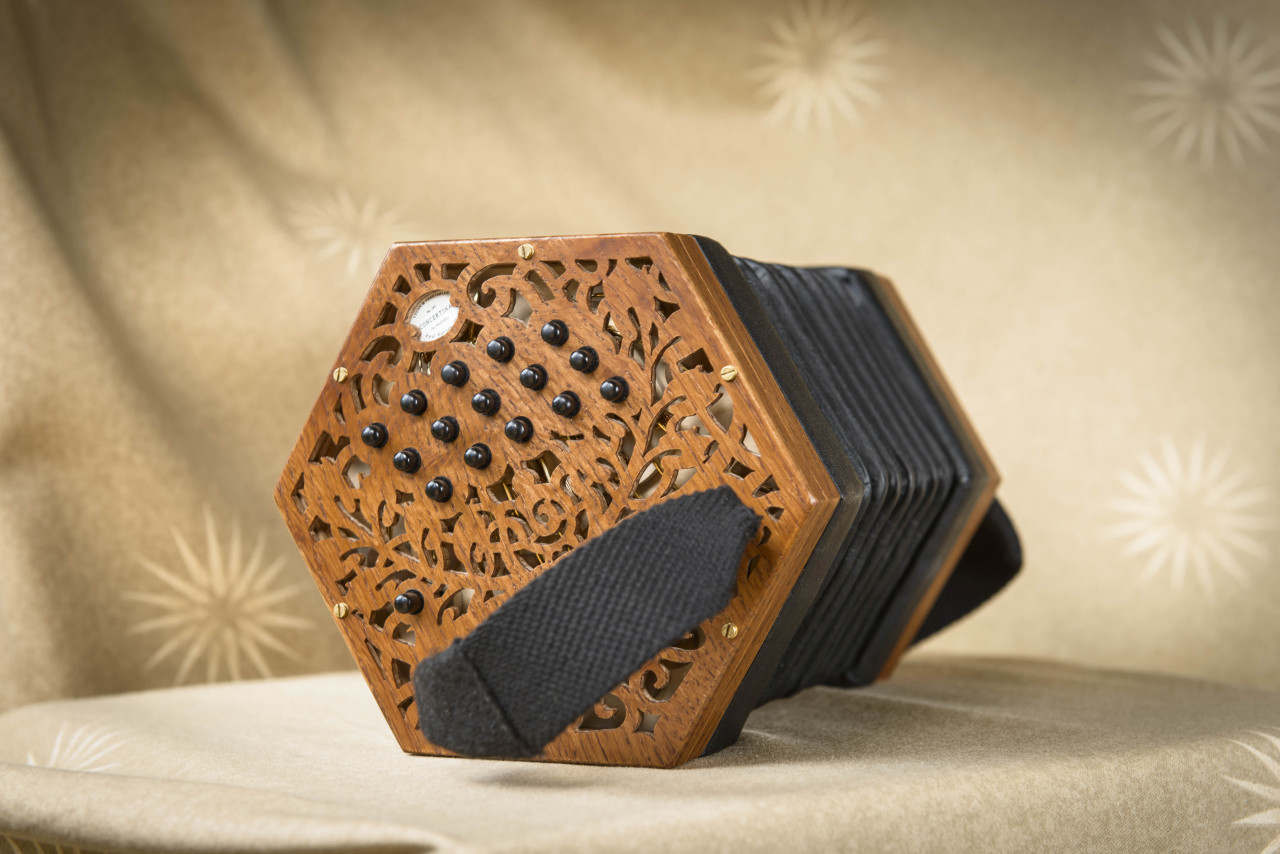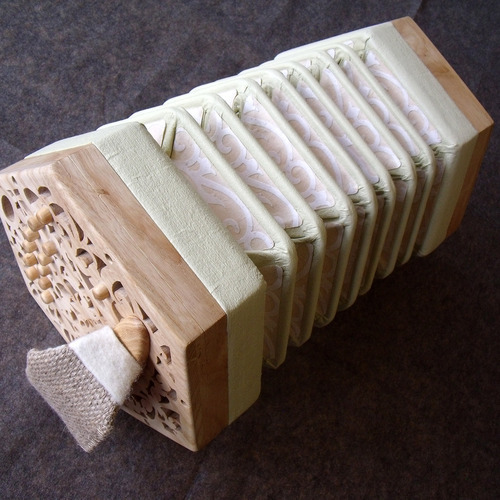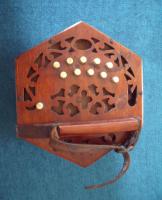-
Posts
101 -
Joined
-
Last visited
Posts posted by Pistachio Dreamer
-
-
A stagi bass, given the size, poorly located so as to avoid being impaled by darts thrown by drunk pirates?
-
Gosh, my ears have been burning! Thanks to Sunbeamer's post I was given the impetus to log back in, I've been very neglectful.
Couple of points in reply to the interest shown above 1. I've got a two year waiting list due to slow turnaround rather than anything else, as making concertinas isn't my full time job, however I do have a couple of commissions in the pipeline at the moment. 2. I haven't made over a hundred concertinas, I'm just going to end up having a cryptic numbering system a la Jeffries (well, I won't be emulating the sound anytime soon). I've actually made 6 for other people, other than my own experiments, all hybrids. I'm hoping to develop a new "hybrid reed", a discussion I may start elsewhere in the forum.
Plus I've settled on "Flying Duck Concertinas" as a name, as I don't only do Vegan instruments. I live near ponds.
Thanks for adding me, and thanks to Sunbeamer for showing off his new concertina, it was a pleasure to make. I should mention that the bellows are by the extremely talented Peter O'Connor.
Paul.
website: www.flyingduckconcertinas.co.uk
-
 1
1
-
 1
1
-
-
Thanks all for your lovely and encouraging comments. Nicx66 the birch bark is a great idea, I am planning some not necessarily vegan, but more "natural" instruments that this would work well with. Also thanks for making an old post hot again with your mis-post!
Jake of Hertford, thanks for your interest, I've applied to join your fb group if its still active. Bellows fabric is made with a layer of cleaning cloth, skived to nothing with the addition of "iron on" interfacing material and a coat of heavy body acrylic and acrylic medium mix. The resulting sections are much harder to stick than leather (to put it lightly!) but function well. The problem with synthetic chamois (PVA cloth) is that it becomes quite rigid when dry, so you need to really work the folds in, which has worked in this case. The latex coated cloths are probably a better bet as they remain supple when dry. In both cases, I've found that the synthetic bellows are momentarily stiff when taking the instrument out from cold, but loosen up well within a few minutes of playing. Just found this from french speaking canada, accordion equivalent perhaps, looks nice- http://www.eco-rdeon.veganquebec.net/wonder if they have the same issues with synthetic fabric bellows
Mike Franch, I think you asked me this before - short answer this time is I'll try and make an English if someone asks me too
 I may well be making a Hayden for someone at some point too! Production? Pass, would have to give up the day job!
I may well be making a Hayden for someone at some point too! Production? Pass, would have to give up the day job!Stephen Chambers, interesting you bring up the rexine example, my first attempt at these bellows were weak at the valleys, I had only used the interface without the cloth as was concerned it would be overall too inflexible. This time I worked out a method of using the full ply, and used a clamp with an embedded plastic wire to "bed in " a good fold in the otherwise too thick material. The nice thing about these bellows over leather is that if you get in a gluey mess (as I did on occasion) you can just wipe them down and put another coat of paint on!
..and thanks CG!
-
Hi All,
In response to this post I was asked if I would make a vegan concertina as a first instrument for someone. So, almost two years later here it is. It uses some old Italian reeds from a 30s accordion, retuned to concertina tuning, which was not actually as difficult as I thought it would be. I have Nigel Sture to thank for this suggestion, and it is a vast improvement on the little German reeds I used previously. I might graduate to new handmade reeds eventually, but at the equivalent of about a tenner for the set you can't really argue with the odd one that might have seen better days. It's more responsive and nicer to play than a Stagi starter, and much louder than my 40s Crabb, which was verified at a session last week where I sat between a whistle and a castagnari!
The previous one was vegetarian, but only due to the wool felt and beeswax finish, which were easily substituted. The bellows fabric here is also different, I used a synthetic chamois as an experiment, which has made for very strong bellows and a good finish, but not quite as supple as the latex impregnated cloth used previously. Still it's good to have a non-latex alternative for those with that allergy. The wood is holm oak which I have stained slightly darker, the internals are sycamore, a good uk alternative to maple for a nice bright sound. Fretwork design is my own, based on the wych elm leaf (I have some wych elm ones in the pipeline). As always, thanks Bob for sharing with me and many others your exquisite skills and insight.
First video here, hope to do some better ones soon: https://youtu.be/UIRHSFvjDwQmore photos here: http://pistachiodreamer.tumblr.com

-
Hi All,
I don't suppose anyone is interested in a couple of tickets to see "The Gloaming" in Liverpool on 2nd November? No concertinas, probably, but a great bunch of performers.
Message me for more info.
-
Interesting topic!
As a songwriter, I occasionally think about music and sustainability. The Bard, after all, is an incipient Druid, and must think things through on a spiritual level. Many years ago, I wrote the following song. Not one of my best, I admit. Those of you who are familiar with German shall judge - for the others, there's a literal translation at the bottom.
Der Herr und der Sänger
Eines Tages ging der Schöpfer in der Welt hienieden,
Um zu schauen nach dem Rechten, wie schon hin und wieder.
Sah sich an, was Menschen trieben
mit der Schöpfung alles;
Ärgerte und freute sich, je nach Art des Falles.
Sah die Männer in dem Walde stolze Bäume fällen,
Hörte auch ihr Jagdgetöse und die Hunde bellen.
Bergleut' wühlten unter Tage,
Abraumhalden wuchsen;
Wo die Leute Erze schmolzen, war der Himmel duster.
Einer aber stand beiseite, ab vom muntern Treiben,
Seine Miene war recht finster, und er war am Schreiben.
Sprach der Herr zu ihm: "Wer bist du?"
"Herr, ich bin der Sänger,
Und die Schändung Deiner Welt dulde ich nicht länger!
"Leute, die die Bäume fällen und die Tiere töten,
Sollen aus den Liedern lernen, Schonung ist vonnöten,
Und dass Schätze dieser Erde
Allzuschnell verschwinden,
Pufft man sie so achtungslos in die freien Winde!"
Sprach der Schöpfer zu dem Sänger: "Kläglich ist dein Singen!
Hättest du bloß Instrumente, tät' es wohler klingen!"
Sprach der Sänger: "Instrumente
Tät' ich wohl begehren,
Würdest Deinem Sänger Du welche doch bescheren."
"Töte," sprach der Herr, "Ein Kalb; mach' aus dem Fell die Pauke!
Und aus Hölzer edler Bäume bau' dir eine Laute!
Lass' dafür die Saiten ziehen
Aus geschmolzenen Erzen;
Spiel zum Tanz, und sing dein Lied dann für frohe Herzen!"
Translation:
The Lord and the Singer (literal translation)
One day, the Creator came down to this world
to see how things were going, as he occasionally does.
He looked at what humans were doing
with all his creation;
was annoyed or pleased, depending on what he saw.
He saw the men in the forest felling proud trees;
heard the cry of their hunt, and the baying of the hounds.
Miners grubbed in the earth,
slag-heaps grew;
where the people smelted ores, the sky was darkened.
But one stood aside, far from the merry activity;
his mien was dark, and he was writing.
The Lord spake to him: "Who art thou?"
"Lord, I m the Singer,
and I will tolerate the desecration of your world no longer!
"People who fell the trees and kill the animals,
shall learn from my songs that conservation is necessary,
and that the treasures of the earth
will vanish all to quickly
if they are puffed so carelessly into the free winds!"
The Creator spake to the Singer: "Your singing is dismal!
If only you had instruments, it would sound fuller!"
The Singer spake: "Instruments
are what I would wish for
if thou wouldst bestow some on thy Singer."
"Kill," spake the Lord, "A calf; make a drum with its skin!
And from the woods of noble trees, build yourself a lute!
Have the strings for it drawn
from smelted ores;
play for the dance, and then sing your songs for light hearts!"
Cheers,
John
Great song, thanks John. I want to hear it!
-
Pistachio, before you create a distinct problem for all of us vintage concertina owners vis a vis the CITES laws by continuing to imply the widespread use of ivory, you should be made aware that Ivory was not commonly used in vintage concertinas. Instead, the buttons were made of bone which, while still not meeting your vegan goals, do no make use of any poached materials or otherwise despicable collection methods. This is material that would have otherwise been disposed of, or as in the case of French prisoners of war in the 1800s were used to make ship models and all kinds of other decorative items that were sold to keep them better fed and alive til the war was over.
Ross Schlabach
Hi Ross,
Many thanks for clarifying the distinction between ivory/bone. In my cynicism I thought the descriptions of "bone buttons" was a euphenism designed to go under the radar of auction selling regs! It does certainly make sense now I think about it that the vast majority would be using bone from less exotic sources. Interesting story about the POWs.
-
this is a cool project. Its nice to see people thinking outside the squeeze box when making these things. BTW where on earth did you get the threaded inserts? they are like so hard to get hold of at the right size.
post a vid of it playing!
Hi Jake,
Thanks for your nice words. The inserts are M2, and yes very hard to find. At this size they are made to be fitted in plastic not wood, so are most commonly found with studded/gnurled sides for friction/heat fixing. I did manage to find a screw-in version, again a very fine thread for plastic fitting, but works fine in hardwood if a little care is taken. The ebay seller is here (http://stores.ebay.co.uk/InsertsDirect-com-Ltd/_i.html?_nkw=m2&submit=Search&_sid=671871966) but I notice they don't have the threaded type any more. If I were to use the non threaded version I would knock them into a slightly undersized hole with a bit of superglue, and be careful to not overtighten the bolts.
I'll have to post a video of its owner playing it, hands don't fit in the straps any more, and as you can see with my acme hand strap fixing prototype, quick adjustment is a bit of a fiddle!
-
I once got asked to convert a Lachenal English System to 'Vegan' status, a lady visited, produced a basic instrument from her plastic bag, and proceeded to explain that she wanted all the animal products taken out of the concertina and got a bit upset when I said that is was not a practical proposition.
I explained (and found myself having to defend) the construction and materials choices mad back in the early 1900's. This covered not only bellows, valves, pads, straps, but glues and even the shellac. She went away more than a bit disappointed, I then got a phone call asking me confirm that the animals whose products were used were all humanely done to death. Not having being around in the early 1900's the best I could manage was the assertion that, given the standards of the day, and the volumes of materials being purchased by Lachenal I felt sure that the killing process would have had to been both clean and efficient. I heard no more.
Not that any of the animals involved would have resented their lives being sacrificed if they had realised that they were to live on in such fine instruments.........
And surely throwing away the animal bits is so much more of a waste - I don't quite understand that mentality. Exception would be modern poached ivory etc., which I understand they have to burn so as not to perpetuate the trade. I think they used to make some high end concertinas with tortoiseshell ends, which to my eyes look quite tacky now, but back then must have been startling to behold. Maybe an alternate thread here - the most carnivorous concertina?
-
Thinking about making any ECs?
Hi Mike, I'm an anglo player, so not as comfortable with the specifics of an EC yet -so none planned presently, but would not rule it out in the future.
-
Wow, that's a fascinating take on instrument material sourcing!
Puts me in mind of Julian Goodacre, makes medieval bagpipes up in Peebles; he takes pride in using wood so local that he generally is familiar with the specific trees invovled. He did a large number of smallpipes based off (iirc) a plum tree outside a local pub that was killed by lightning strike, which he corded and aged for a number of years and then lathed into pipes.
Fantastic story and inspiring maker, thanks for the link. I managed to save a few chunks of an impressive old yew tree that used to stand outside my girlfriend's family home until it was felled recently. It does feel good to have a personal connection with the materials you work with.
-
Nice! Love the "natural" look.
So, no leather reed valves then?
Thanks! Indeed not, they're the "vileda" type supplied by CGM.
-
Hi all,
About a year ago I was commissioned to make a concertina by a friend of excellent taste, with the brief being to make it as eco/"green"/sustainable as possible, and totally veggie. I've always thought that the traditional concertinas, as very much a product of Victorian design, leave a lot to be desired in this respect; exotic hardwoods, ivory buttons, leather. All the more reason to restore and cherish them. I wouldn't say modern concertinas have bad green credentials in the slightest, but I don't see any instruments being made that specifically cater for the vegetarian, planet-conscious market, which I can only assume would be appealing to the folk music scene... Of course in achieving this there has to be compromises- and here it is, my scratch-built prototype eco concertina! Of course, huge credit goes to Bob Tedrow for his photo essay.

For some more images and sound files see my tumblr blog: http://pistachiodreamer.tumblr.com/
here is the basic specification:
Case, handrests and buttons: Sweet chestnut (native, reclaimed board), finished with Stones beeswax based polish.
Internals and bellow frame: Native lime
Hand straps: Hessian webbing with 2ply felt lining (undyed 100% merino wool)
Bushings: undyed 100% merino wool felt.
Bellows: 7 fold, with recycled card, linen tape, faux leather made with synthetic chamois, interfacing fabric and acrylic mediums. Straw and rhino-dung based recycled paper.
Pads: Recycled board and synthetic chamois
Lever arms, posts and rivets, all fixings: all brass
Reeds: Butchered up from a variety of German instruments - mainly brass, with a few steel. 23 key in C/G (Lach style with the extra two accidentals in-line with the C-row, and an extra C/C drone on the left thumb.)
If I were to do this again, which I hope to, I will look to improving the bellows materials and binding and using better reeds. It was great fun to make, a good learning experience, and materials-wise probably only cost about £100. It plays fine for a beginner's instrument, and the large bellows compensate for a little leakiness!
-
I'm not buying it. What I see is someone used their little finger as a brace, I see people doing this a lot. The marks between the C row and accidental row around the 4th and 5 th buttons are from the same thing, the third and fourth fingers placed between the buttons as a brace to keep the end steady, especially when using the air button at the same time as playing a note. One of my students, a 12yr old, does exactly that.
As a further clue, put the instrument on and see if you can get your thumb onto that dent, your hand would have to be on a very strange angle.
This is a cheap instrument, it would have needed a stronger hand to get volume and pace from it, I think these marks are a sign of a determined player.
Sounds very plausible, though I do still find it easier to hook my thumb round the end of the hand rest and into the dent than get my little finger anywhere near it, but my hands are large. As a budget model it would no doubt have been played by a young (and determined) student.
-
Possibly that the finger wear patterns around the buttons are reversed from the usual? Have reeds been swapped about inside?And it looks like someone has retrofitted an old belt as a handstrap?
It is the finger wear patterns that are reversed from the usual that caught my attention, and I think, as Ransom suggests, this shows that whoever played this instrument held it upside-down/backwards, using the little finger on the air button. The reeds are in their normal positions. The LH side wear pattern is mirrored but less pronounced. There's an account of someone playing in this manner reported in an article on the Crabb firm here: http://www.concertina.net/rd_crabb.html Never seen evidence of this peculiar technique before. Thanks for your replies!
-
-
Hi Matthew,
My advice would be to pick up another instrument, I've got 20 key bastaris ofrom ebay for under £30 recently -not sure if this is the same situation in the states. Also search for cheaper "Stagi" models as these are likely to be similar. Then you have plenty of spare parts to combine into a more functional instrument. These bellows tend to have much shallower and greater number of folds when compared to more traditionally made instruments, so I'm not surprised that any new gussetting or rebinding would have the effect you are describing, you would want to use very thin and supple material if you were to try. Bear in mind that when new these bellows are fairly stiff anyway, so if you can find an older instrument that looks well played in but undamaged, so much the better.
If you do find a spare set of bellows that are the same size, be aware that you will probably run into difficulties aligning the end screws with the holes in the bellows frames. The solution here would be to rebore the bellows frames using your existing ends as templates, and install threaded inserts for a new set of end bolts. This is inexpensive to do and a great improvement on the woodscrews which tend to fail with repeated removals.
Have fun,
Paul.
-
"A good day to squeeze hard"?!
-
They need one. If anyone is interested the two listings they are using (a C. and a W. Jeffries), were originally listed in December and appeared to go for around $4000 each.
-
That's it reported. Looks like they're hitting the states now.
-
Was back up again for about 4 hours. I spotted it just now, reported it, and did some refreshes and it was delisted within the minute of my reporting. Good this seems to be working but would be better if ebay learnt not to rely on us. I do check concertina newly listed items like a nervous twitch, but that may not always be the case, and a few hours might be enough to hook someone in.
-
At least in this case the scams are so obvious. I would not say this is necessarlily an indictment on ebay, just a caveat emptor and a warning to be vigilant which goes in any case when you are thinking of spending your heard-earned cash. Though you would think with 28 thousand employers they would be able to police it better! Remember, if it is too good to be true it probably isn't!
-
Sounds like someone replacing broken reeds with whatever was available. I've seen it a couple of times. As to whether it will work, only way is to listen to it and see if you like it the way it is, and if not look for replacements...
Thanks Chris, quite a bit of work to do before getting it sounding at all (bellows are shot, trying a rebind first before biting the bullet), but I will certainly follow that advice when I do. In fact I do like the recordings I've heard of instruments that seem to have slightly different "voices" between reeds or reed rows, it all adds to the charm and beauty. Though I imagine what I am liking is the skilled playing of priceless instruments rather than differences in reed materials!
-
Would be very interested in any South UK workshops.
Paul.




Custom G/D/C# Anglo Layout- Would it work?
in General Concertina Discussion
Posted
I don't think you will really know for sure until you try it. Two ideas for a less expensive prototype so you could try it before committing to an expensive traditional reed re-build:
1. Convert a duet, the lachenals aren't too pricey for the number of reeds they contain. I'm aware this was done quite frequently with particularly Jeffries duets to anglos, so whilst I've not tried myself to appreciate the possibilities, I would have thought the same principals should apply here. It might be an octave up of course.
2. Cobble together an accordion reeded version out of cannibalised parts. Who on earth keeps old bits of concertinas lying around? Answer, a large percentage of people on this forum, if we're being honest.
For both options there might be ways to allow for further tinkering and reed swapping before settling on a favourite. The chart reminds me of as simple anglo I made for a gentlemen who didn't like the way the notes at the extreme ends of the instruments didn't follow on logically from the pattern in the middle, so his had the scale pattern simply continuing more like a melodeon, and I recall the resulting chords along the rows were rather interesting sounding, which wasn't a problem for single line tune playing of course.